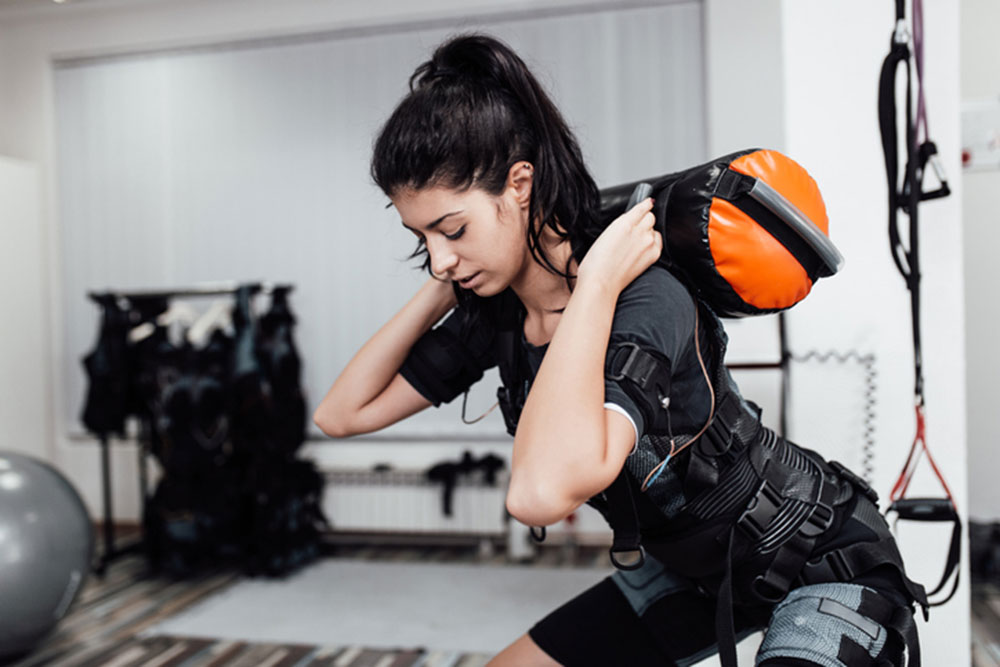
iStock
By Mary Carpenter
PARIS-BASED lawyer L.M. credits greatly improved strength and body toning —more than she’d achieved from a daily swim of one mile, 45 minutes of hula-hooping or weight training—to twice-weekly 20-minute “EMS workouts.” Electrical muscle stimulation, delivered by what looks like a police vest plus wide bands on the arms, quads and glutes, is popular in Europe and coming slowly to the U.S.– with workouts purporting to offer the equivalent of 90 to 240 minutes of strength training in just 20 minutes.
EMS creates enough resistance to make the movements—low-impact combination of lunges, squats and planks with some weight-lifting movements; or even Pilates or yoga—feel more difficult and more quickly fatiguing. But EMS has helped “seniors with muscle atrophy” and those wishing to build back muscles after an injury as well as world athletes, according to WB20.io.
Compared to regular exercising, using electrical stimulation engages more large and small muscle fibers. The studio workouts—with a trainer who sets the electrical dose and directs the accompanying exercises—can cost from $50 to $100 a session. Research has found exercising with EMS leads to “a slight strength increase,” although the effects might be temporary and overdosing the electricity is a risk.
(EMS that accompanies workouts is different from passive electrical stimulation, called “E-stim,” used in physical therapy following injuries or surgery; and from TENS—transcutaneous electrical nerve stimulation—that works on nerves to help deal with chronic pain.)
“Life is nothing if not electrical,” writes Georgetown radiologist Timothy J. Jorgensen in his new book Spark, quoted in a New Yorker review by Jerome Groopman. Conditions like epilepsy and migraines may resemble “an electrical storm in the brain,” Groopman explains, describing the early 20th century “medical craze for electrical treatments to address anything from headaches to bad thoughts.”
To date, body zapping is the only widely available method employing artificial stimulation of muscle and nerve tissue. But other exciting possibilities focus on neuromodulation—using electricity and magnets to alternatively stimulate and inhibit neuronal activity in the cortex. Researchers have linked neuronal damage and death in the brain to depression and neurodegenerative diseases, such as MS, Parkinson’s Disease and Alzheimer’s (AD). Despite anecdotal evidence and good results in small groups of patients, however, most neuromodulation techniques still await documented proof of effectiveness.
Among stimulation methods, most use electrodes or magnetic coils that can penetrate bone and allow “painless stimulation of the brain”—compared to the more invasive DBS (deep brain electrical stimulation), which requires surgery to implant electrodes.
Positioning electrodes on the skin to create an electrical field has the advantage of being able to locate and excite tissues in a small target area. A device that can be used at home employs Transcranial Direct Current Stimulation (tDCS) to help treat depression, schizophrenia and epilepsy. One analysis of 12 studies on dementia patients found that tDCS improved working memory and language. And combining tDCS with cognitive training is the focus of a new study that includes participants with subjective cognitive decline—indiscernible by neuropsychological measures but suggestive of early AD, which can begin years before diagnosis of better-studied Mild Cognitive Impairment (MCI).
Another device for home use, Transcranial Electrical Magnetic Treatment (TEMT) employs magnets to create an electric field that can penetrate the entire forebrain and impact “intraneuronal” pathologic processes” —including breaking up aggregates of the beta and tau proteins suspected of playing a role in AD. In one trial of eight patients, TEMT enhanced cognitive performance in seven of the participants.
Transcranial Magnetic Stimulation (TMS) is the most widely used and best-supported by research of the neuromodulation techniques involving artificial stimulation. Among more than 65,000 patients to date, TMS— using large magnetic coils to create an electric current in nearby neurons— has helped with severe, treatment-resistant depression in about 75%. Patients must remain immobile during the half hour or so of treatment—usually five days a week for four to six weeks. (Popular, at-home “TMS” devices in fact use the less well-proven tDCS.)
A new version of TMS called Theta-Burst Stimulation (TBS) works more rapidly and has shown good results for patients with major depression considered at risk for suicide. In a Stanford University study of 20 people who had not responded to treatment with at least one antidepressant medication, 90% “went into remission,” and 60% maintained their improvement one month later—with some patients experiencing relief from “brain chatter” during the first day.
Finally, neurofeedback is a different approach to neuromodulation that uses electrodes placed on the scalp to detect, rather than stimulate, electrical activity in the brain. The patient plays a computer game, watches a video or listens to music—and these stop whenever the patient’s brain wave patterns veer away from a pre-determined optimal range.
For one patient diagnosed with MCI, who struggled with “brain fog” for about 10 years starting in puberty, brain scans showed reduced blood flow in parts of the brain that seemed “to align with my complaints of cognitive decline,” writes Peter Fox in the Washington Post. After about 100 sessions over two years, Fox learned to “control the brain waves —by staying focused on the music for instance.”
“Neurofeedback turned the lights back on,” said Fox. In one large review study, dementia patients scored better on different cognitive tests following neurofeedback, which is slowly gaining recognition for use with epilepsy, insomnia and ADHD. But Brown University neuroscientist Laurence Hirshberg cautioned, “no area of [its] application has been fully validated.”
While EMS workouts entice with the possibility of quicker and maybe better results, driving 45 minutes to a DC-area studio seemed too much for me—only to try exercises that seem arduous enough without adding resistance. I might experiment if a studio opens nearby—but only after hearing many trustworthy reviews.
Mary Carpenter regularly reports on topical subjects in health and medicine.

Please write follow-up articles of tDCS and TEMT….